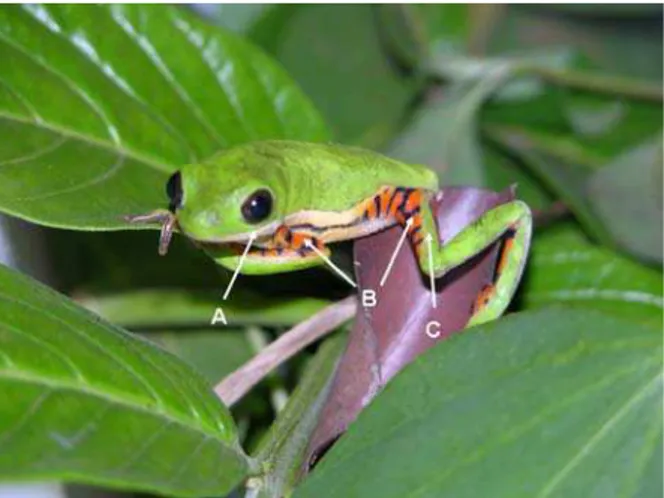Check List
4(1): 55–56, 2008. ISSN: 1809-127XNOTES ON GEOGRAPHIC DISTRIBUTION
55
Amphibia, Anura, Hylidae, Phyllomedusa azurea: Distribution extension.
Vitor Hugo M. do Prado Rinneu E. Borges Fernando R. da Silva
Thiago T. Tognolo Denise de C. Rossa-Feres
Departamento de Zoologia e Botânica, Universidade Estadual Paulista (UNESP), Campus de São José do Rio Preto. Rua Cristóvão Colombo 2265, CEP 15054-000, São José do Rio Preto, SP, Brazil.
E-mail: vitorbioibilce@yahoo.com.br
Phyllomedusa azurea Cope, 1862 (Figure 1), was
recently revalidated and included in the species group of Phyllomedusa hypochondrialis (Daudin, 1800) by Caramaschi (2006). The geographic range of P. azurea was then published as the open formations of the Chacoan regions of Bolivia, Paraguay, and northern Argentina, and in the Pantanal and Cerrado regions of central Brazil (Caramaschi 2006; Frost 2007). Herein, we present the first record of P. azurea for the state of São Paulo, Brazil.
Figure 1. Phyllomedusa azurea. Arrows show three
of the diagnostic characters of this species according to Caramaschi (2006). A, narrow white stripe on the upper lip, not reaching the lower eyelid; B, inguinal region and sides of members with black transversal bars over an orange or red background; C, wide green stripe along the dorsal surface of thighs.
___________________________
Two calling males were heard and one was collected in the municipality of União Paulista (20º55'54" S, 49°56'41" W) by R. E. Borges and
F. R. Silva in 25 October 2006. The specimen was found perching on vegetation (Poaceae:
Brachiaria sp.) within a permanent pond in a
pasture area, ca. 350 m far from a semideciduous forest fragment. The pond has 3,118 m2 of total area, 90 cm of maximum depth, and 70 % of plant cover (Poaceae). This record now represents the southeastern limit of the distribution of P. azurea (Figure 2), which is ca. 360 km from the nearest locality previously known for this species (Serranópolis, in the state of Goiás, Brazil 18°17'37'' S, 51°58'10'' W).
The voucher specimen was identified according to the diagnosis presented by Caramaschi (2006) and deposited in the Coleção do Departamento de
Zoologia e Botânica (DZSJRP-16604) housed at
UNESP, São José do Rio Preto, São Paulo, Brazil. According to Caramaschi (2006), the revalidation of P. azurea and the recognition of P. nordestina Caramaschi, 2006, both previously identified under the name P. hypochondrialis, demonstrate that three morphologically similar species are associated to three of the great morphoclimatic domains of South America (sensu Ab'Sáber 1977): P. hypochondrialis with Amazonian distribution, P. nordestina associated to the Caatinga region, and P. azurea occurring in the Cerrado-Caatinga-Chaco complex (Cei 1980; Caramaschi 2006; Frost 2007). The record of P.
azurea in the northwestern region of São Paulo
Check List
4(1): 55–56, 2008. ISSN: 1809-127XNOTES ON GEOGRAPHIC DISTRIBUTION
56 Figure 2. Distribution map for Phyllomedusa azurea with the new record for the municipality of União Paulista, State of São Paulo, Brazil (red dot).
________________________________________________
Acknowledgements
The authors are grateful to Célio F. B. Haddad for the identification of the specimen collected, and to FAPESP (grant 06/51534-1) for financial support.
Literature cited
Ab'Sáber, A. N. 1977. Os domínios morfoclimáticos na América do Sul, primeira aproximação. Geomorfo-logia 52: 1-21.
Bernarde, P. S. and M. N. C. Kokubum. 1999. Anuro-fauna do município de Guararapes, estado de São Paulo, Brasil (Amphibia, Anura). Acta Biologica Leopoldensia 21: 89-97.
Caramaschi, U. 2006. Redefinição do grupo de
Phyllomedusa hypochondrialis, com redescrição de P. megacephala (Miranda-Ribeiro, 1926),
revalida-ção de P. azurea Cope, 1862, e descrirevalida-ção de uma nova espécie (Amphibia, Anura, Hylidae). Arquivos do Museu Nacional 64(2): 159-179.
Cei, J. M. 1980. Amphibians of Argentina. Monitore Zoologico Italiano (n. s.) Monograph 2: 1-609. Frost, D. R. 2007. Amphibian Species of the World: an
online reference. Version 5.0. Electronic Database accessible at http://research.amnh.org/herpetology/ amphibia/index.php. American Museum of Natural History, New York. Captured on August 2007. Rossa-Feres, D. C. and J. Jim. 2001. Similaridade no
sítio de vocalização em uma comunidade de anfíbios
anuros na região noroeste do Estado de São Paulo, Brasil.RevistaBrasileiradeZoologia18(2):439-454. Santos, T. G and D. C. Rossa-Feres. 2007. Similarities
in calling site and advertishment call among anuran amphibians in Southeastern Brazil. South American Journal of Herpetology 2(1): 17-30.
Santos, T. G., D. C. Rossa-Feres, and L. Casatti. 2007. Diversidade e distribuição espaço-temporal de anu-ros em região com pronunciada estação seca no sudeste do Brasil. Iheringia (Zoologia) 97(1): 37-49.
Vasconcelos, T. S. and D. C. Rossa-Feres. 2005.
Diversidade, distribuição espacial e temporal de anfíbios anuros (Amphibia, Anura) na região noroeste do estado de São Paulo, Brasil. Biota Neotropica 5(2): 1-14.
Vizotto, L. D. 1967. Desenvolvimento de anuros da região norte-ocidental do estado de São Paulo. Faculdade de Filosofia, Ciências e Letras, Zoologia n° especial: 1-161.
